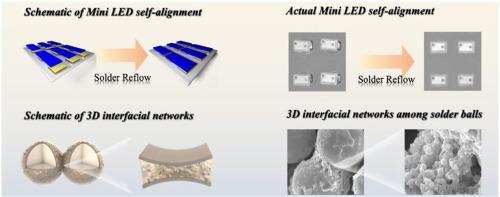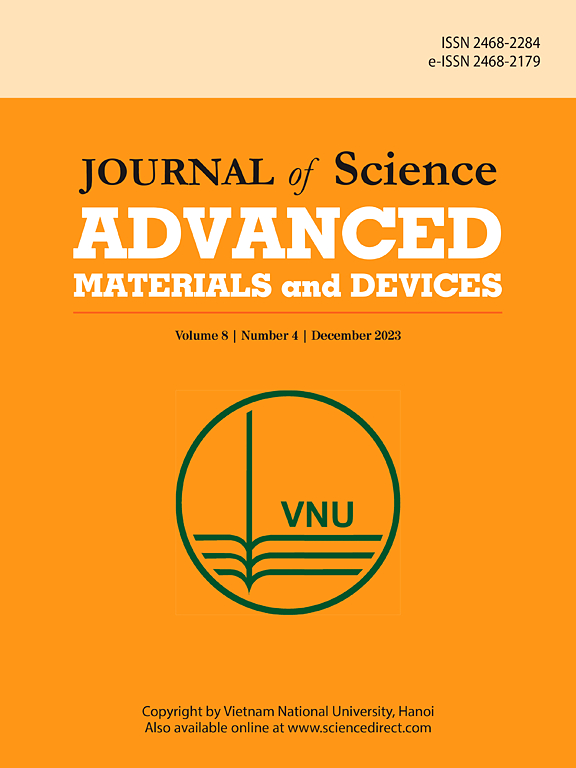A polyamide-facilitated soldering approach for Mini LED precise alignment leveraging 3D interfacial networks
IF 6.7
3区 材料科学
Q1 MATERIALS SCIENCE, MULTIDISCIPLINARY
Journal of Science: Advanced Materials and Devices
Pub Date : 2024-11-19
DOI:10.1016/j.jsamd.2024.100817
引用次数: 0
Abstract
Driven by the need for improved quality, energy efficiency, and visual innovation, display technology has evolved from CRT to Mini LED. However, the transfer process in Mini LED assembly poses challenges in precision. This study addressed the displacement issue during the transfer process by investigating the synergistic effects of solder and functional organic chemicals. Through the Mini LED assembly process, with the Mini LED size measuring 150 μm (length) ∗ 100 μm (width) ∗ 70 μm (thickness), polyamide was identified as a facilitator for precise alignment, which enhanced self-alignment capabilities by 68.8 % and improved the accuracy on self-aligned distance from 12.5 μm to 21.1 μm in Mini LED packaging. Through the powder coalescence approach, further extensive analysis using XPS, SEM, FTIR, and DSC reveals the synergistic effects. It supports the proposed three-dimensional polyamide-tin ion coordination interfacial network construction mechanism that facilitates solder-to-solder self-alignment and coalescence. This study provides insight into such a polymer-metal ion 3D coordination network for Mini LED precise alignment, which is promising for mass production.

利用三维界面网络实现 Mini LED 精确对准的聚酰胺促进焊接方法
在提高质量、能源效率和视觉创新需求的推动下,显示技术已从 CRT 发展到 Mini LED。然而,Mini LED 组装中的转移过程在精度方面存在挑战。本研究通过研究焊料和功能性有机化学品的协同效应,解决了转移过程中的位移问题。通过 Mini LED 组装过程,在 Mini LED 尺寸为 150 μm(长)∗ 100 μm(宽)∗ 70 μm(厚)的情况下,聚酰胺被确定为精确对准的促进剂,可将自对准能力提高 68.8%,并将 Mini LED 封装中自对准距离的精度从 12.5 μm 提高到 21.1 μm。通过粉末凝聚方法,利用 XPS、SEM、FTIR 和 DSC 进行的进一步广泛分析揭示了协同效应。这支持了所提出的三维聚酰胺-锡离子配位界面网络构建机制,该机制可促进焊料之间的自对准和凝聚。这项研究深入探讨了这种聚合物-金属离子三维配位网络对 Mini LED 的精确对准,为大规模生产带来了希望。
本文章由计算机程序翻译,如有差异,请以英文原文为准。
求助全文
约1分钟内获得全文
求助全文
来源期刊

Journal of Science: Advanced Materials and Devices
Materials Science-Electronic, Optical and Magnetic Materials
CiteScore
11.90
自引率
2.50%
发文量
88
审稿时长
47 days
期刊介绍:
In 1985, the Journal of Science was founded as a platform for publishing national and international research papers across various disciplines, including natural sciences, technology, social sciences, and humanities. Over the years, the journal has experienced remarkable growth in terms of quality, size, and scope. Today, it encompasses a diverse range of publications dedicated to academic research.
Considering the rapid expansion of materials science, we are pleased to introduce the Journal of Science: Advanced Materials and Devices. This new addition to our journal series offers researchers an exciting opportunity to publish their work on all aspects of materials science and technology within the esteemed Journal of Science.
With this development, we aim to revolutionize the way research in materials science is expressed and organized, further strengthening our commitment to promoting outstanding research across various scientific and technological fields.
 求助内容:
求助内容: 应助结果提醒方式:
应助结果提醒方式:


